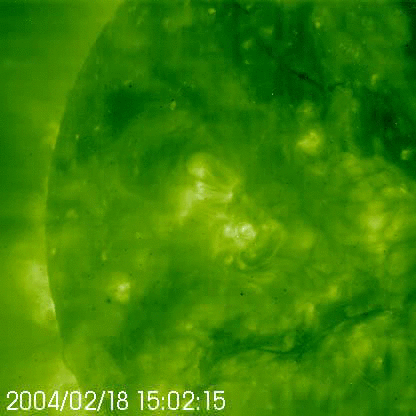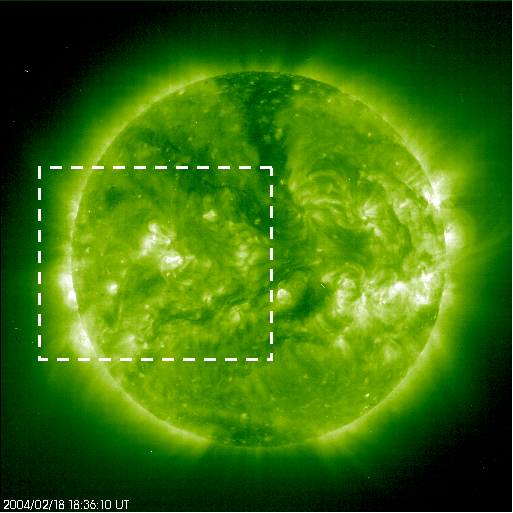What is it?
EIT on the spacecraft SOHO is a telescope which collects photons coming mainly from the Sun during some 10 to 20 sec. During this time, the door or shutter of the instrument is open allowing the photons to enter. After the shutter is closed, the collected data are readout and sent to a computer. EIT takes almost 4 pictures of the Sun every hour by repeating this process.

In the shutterless EIT campaign, we don’t do the shutter-thing anymore. The shutter-door is always open: 68 sec of photon-collection, 0.25 sec readout-time during which additional noise photons are troubling the picture. This induced noise is really small and can easily be erased. After 68.25 sec, a new picture is made, and again,.... Such a shutterless run is performed during 3 times 40 minutes. Above the last shutterless EIT-movie of the part of the solar disc in the rectangle on February 18, 2004 (see below). Movies of other shutterless campaigns can be found on the High Cadence website.
Field of View
A scientist at the SIDC picks a part of the Sun which has at that moment the most interesting features. EIT zooms in at almost one quarter of the normal EIT-picture size. The resolution in space of this new quarter picture is the same as a full-disk EIT-picture. Otherwise said, you take an EIT-picture of the whole Sun and you throw away three quarters. So, zooming in, doesn’t mean the picture gives more details.

The same resolution in space as a normal EIT picture, but what do we gain?
You get a high resolution in time: every 68.25 sec a new picture until the computer memory is full. Taking one quarter of the Sun, the stocking place for the data is completely filled up after 2 hours of shutterless run. A shutterless run for the full solar disc could last for only 30 minutes.
This high time-resolution offers one the possibility to study features with a time-scale in the order of minutes. Image a blob of plasma in the corona falling down in 10 minutes. In the shutterless campaign, you can nicely follow the track of the blob. In one full-disc EIT picture, you can see the blob, while in the next full-disc picture taken after 15 minutes, it disappeared already!
Scientific Results
The shutterless runs have been a resounding success leading to highly relevant scientific outcome. Wave periods were measured, flare-like brightenings of very small active regions could be linked to the so called "active region transient brightenings" seen in pictures made by SXT (Soft X-ray Telescope), intensity variations could be identified as flowing/falling plasma blobs. If you want, you can take a peek: 1 , 2 , 3 , 4 , 5 .





